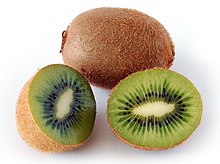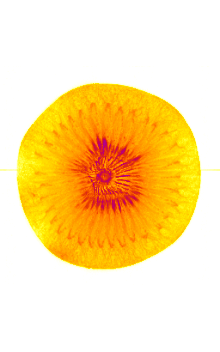Kiwi fruit
As kiwi , kiwi fruit or Chinese gooseberry which is called berry fruit of several species of Actinidia . Originally all kiwi species come from East Asia . The fruit is known as "the kiwi" (female), while the bird is "the kiwi " (male).
history
The following types are marketed today:
- Actinidia deliciosa - it provides the majority of the commercially available kiwis.
- Actinidia chinensis - marketed among other things as "Kiwi Gold".
- Sharp-toothed ray pen ( Actinidia arguta ) - a frost-hardy species with small fruits, in trade a. a. Available as "Kokuwa", " Weiki " or "Maki".
- Siberian ray pen ( Actinidia kolomikta ) - particularly frost hardy, but not very suitable for commercial cultivation, as the fruits are small and fall off quickly.
The fruit, initially referred to as "Chinese gooseberry", originally comes from the Yangtze River in northeast China. In the local forests it grows as a strong, woody liana or climbing shrub. The original name of the kiwi fruit - based on Actinidia chinensis - is Yang Tao . This historical name in the 19th century is rarely used in today's Chinese for kiwi fruit and could easily be confused with the current star fruit of the same name (Yang Tao, 杨桃). The common name in China, Taiwan, and other Chinese-speaking countries / regions is currently Mi Hou Tao for native kiwis (猕猴桃) or Qi Yi Guo for imported kiwis (奇异果).
The fruit was introduced to New Zealand in 1904 by a teacher from a stay in China and enjoyed increasing popularity. In 1952, Actinidia deliciosa began to be exported from New Zealand to England for the first time, where it was exceptionally well received on the fruit market and was soon exported to continental Europe and North America. In 1959 it was given the name “Kiwi” in London, after the bird of the same name .
In Germany , kiwifruit was a trend fruit in the late 1970s and early 1980s. In the period from 1972 to 1981, the consumption of kiwis in the country rose from 900,000 to 85 million. However, kiwis did not enjoy undivided popularity. The gastronomy critic Wolfram Siebeck , for example, described the kiwi as a “tasteless softie” who is “no good at all”.
Economical meaning
In 2018, 4,022,651 tons of kiwi fruits (all varieties) were produced worldwide. The People's Republic of China accounted for more than half of the total global harvest. Europe produced 939,926 tons in the same period. The largest producers were Italy, Greece and France.
The ten largest producers in the world together generated 98.4 percent of the total harvest in 2018.
| rank | country | Quantity (in t ) |
|---|---|---|
| 1 |
|
2,035,158 |
| 2 |
|
562.188 |
| 3 |
|
414.261 |
| 4th |
|
266,319 |
| 5 |
|
265.280 |
| 6th |
|
230.267 |
| 7th |
|
61,920 |
| 8th |
|
53,201 |
| 9 |
|
34,290 |
| 10 |
|
34,057 |
| remaining countries | 65,710 |
Nutritional value and ingredients
100 g of the kiwifruit from southwest China have a physiological calorific value of 210 kJ (51 kcal) and contain:
- 9 g carbohydrates, 1 g fat
- Minerals : 2 mg sodium, 320 mg potassium, 40 mg calcium, 25 mg magnesium, 30 mg phosphate, 0.8 mg iron, 0.1 mg zinc
- Vitamins : 45 µg beta- carotene (provitamin A), 0.5 mg vitamin E, 0.02 mg vitamin B1, 0.05 mg vitamin B2, 0.02 mg vitamin B6, 20 µg folic acid, 45 mg vitamin C.
Web links
Individual evidence
- ↑ Mike Boland and Jaspreet Singh: Handbook of Proteolytic Enzymes. Volume 2, 2013, p. 1879, Online , doi: 10.1016 / B978-0-12-382219-2.00428-2
- ↑ Color in the salad. In: Der Spiegel 49/1982. December 6, 1982. Retrieved August 18, 2017 .
- ↑ a b Crops> Kiwifruit. In: Official FAO production statistics for 2018. fao.org, accessed on May 11, 2020 .
- ↑ The Kiwi apotheken-umschau.de


